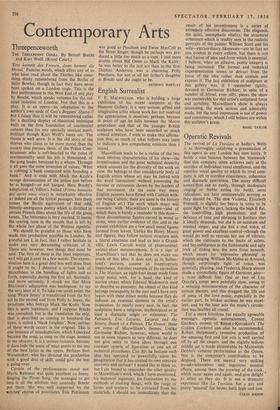English Surrealist
F E. MACWILLIAM, who is holding a large exhibition of his recent sculpture at the
Hanover Gallery, is a very serious, gifted and imaginative artist whose work has not received the appreciation it deserves, perhaps because in point of age he falls between the Moore generation and that of the younger British sculptors who, have been accorded so much critical attention. I wish to make this affirma- tion first, as much of what follows may seem to indicate a less sympathetic estimate than I intend.
Macwilliam tends to be a victim of the two' most obvious characteristics of his show—the inventiveness and the great technical dexterity which account for the diversity of the work on view. He belongs to that considerable body of English artists whose art may be linked with the word 'surrealism' without possessing the fervour or extremism shown by the leaders of that movement. (In the same way many English painters have flirted with Cubism with- out being Cubists; there are none in the history of English art.) The work which many will associate with Macwilliam's name—'and of which there is barely a reminder in this show— those discontinuous figures carved in Wood or stone, were earlier evidence of this and in the present exhibition are a few small metal figures formed from leaves. Unlike the Henry Moore leaf figures, they follow natural structure with a literal exactness and lead us into a Grand- ville, Lewis Carroll world of plantranimal, animal-plant metamorphosis. It is a sign of Macwilliam's tact that he does not make too much of this idea; it does not, as in Suther- land's pictures, assume an inappropriate importance. Another example of his surrealism is The Mariner, an tight-foot image made from scrap metal with, for a head, the kind of marine object which Edward Wadsworth used to describe so precisely. An object of this kind belongs inescapably to the past and I have only begun with these minor works because they do indicate an essential element in the artist's inspiration. In nearly every case, in fact, the sculptures have a religious, mythological or at least a dramatic origin or reference; The Patriarch, Eve, Lazarus, Lazarus and the Sisters, Death of a Painter, The Orator, these are some of Macwilliam's themes. Unlike Germaine Richier, however, whose world is not in some respects so very different, he does not give unity to these ideas through one constant system of figuration or one set of technical procedures. Can this be because each idea has operated so powerfully upon his imagination that it has created its own separate anatomy and surface? I would like to think so, but I am hound to remember the other quality in Macwilliam's work which I have mentioned, his technical ingenuity, his fascination by the methods of making things, with the range of forms and textures to be extracted from his materials. I should say immediately that the result of his inventiveness is a series• of extremely effective discoveries. The elegance, the quiet, unemphatic vitality, the structural coherence which is readily seen in the realistic portraits of the painter William Scott and his wife—extraordinary likenesses—are in fact no less evident in every exhibit, but there is not that fusion of idea and form which is essential, I believe, when an allusive, poetic imagery is being recreated. The formal and technical experimentation seems to detract from the force of the idea rather than contain and express it. The last exhibition of sculpture at this gallery was, if I remember rightly, devoted to Germaine Richier; in spite of a number of trivial, even silly, pieces the show
was memorable for this artist's sculptural force and certainty. Macwilliam's show is always interesting, the work serious and admirably made, but the total impression is not of power and consistency, which I still believe are within this'sculptor's grasp.
BASIL TAYLOR


































 Previous page
Previous page